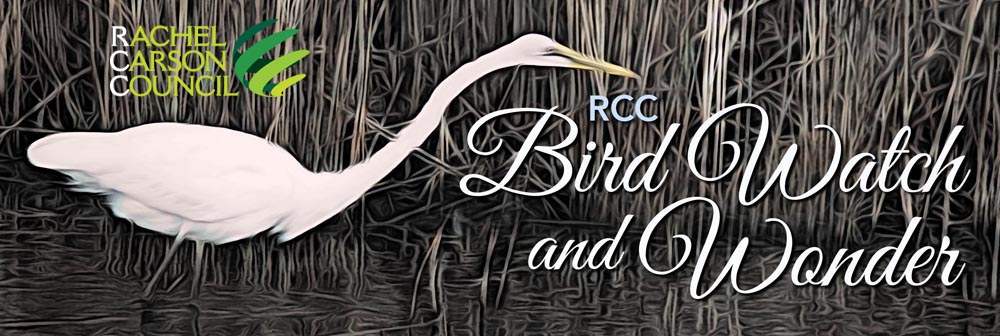 | | | May is typically the month for straining our necks to get a glimpse of colorful treetop warblers in spring migration. But, sadly, each year there are fewer of our favorite birds passing through. That is why our May issue of RCC Birdwatch and Wonder is a celebration of the millions of birds that we still do have, their endless fascination for us humans, and the impressive ways in which we weave them into our literature and art, invite them into our homes, find ways to protect them, and ingeniously restore the ecosystems they depend on. 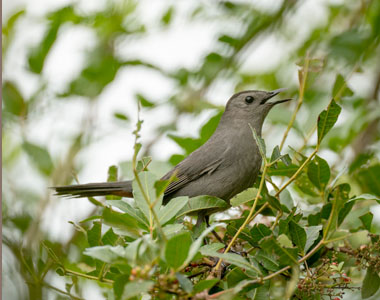 We live so close to birds that in fact, our homes are really their homes, as Caitlin Gibson reminds us in her charming story, “How to Coexist With a Belligerent Catbird.” In a similar vein, like Rachel Carson before her, Margaret Rankl, author of The Comfort of Crows, admits that despite the many problems they have caused, she “has fallen in love with starlings.” We live so close to birds that in fact, our homes are really their homes, as Caitlin Gibson reminds us in her charming story, “How to Coexist With a Belligerent Catbird.” In a similar vein, like Rachel Carson before her, Margaret Rankl, author of The Comfort of Crows, admits that despite the many problems they have caused, she “has fallen in love with starlings.”
Even in a world at war, Brian Pfeiffer celebrates with photos and prose the beauty and transcendence of our migrating birds that offer a vision of what could be. That vision and the allure of birds are so strong that Rebecca Gordon delightfully captures her astonishment and joy, while taking Birding 101, at her first look at that cutest of backyard species, the Tufted Titmouse. Marveling at birds is so universal, she writes, that even in Gaza, amidst immense destruction, birders Mandy and Lara Sirdah worked to find them despite difficulties and dangers in order to document every species and create the first authoritative checklist — The Birds of the Gaza Strip — Palestine. 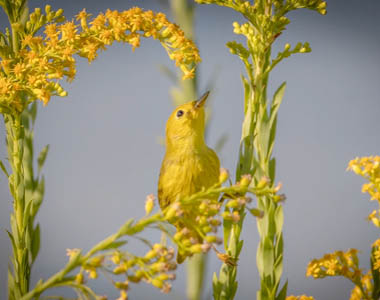 Fortunately, our fascination with birds here in the United States means that, increasingly, we are acting to protect them. In “Action and Advocacy,” you will see that President Biden has signed into law “The Migratory Birds of the Americas Conservation Enhancements Act” that will help reverse bird declines through a federal grants program that will fund migratory bird research and habitat restoration throughout the Western Hemisphere. Fortunately, our fascination with birds here in the United States means that, increasingly, we are acting to protect them. In “Action and Advocacy,” you will see that President Biden has signed into law “The Migratory Birds of the Americas Conservation Enhancements Act” that will help reverse bird declines through a federal grants program that will fund migratory bird research and habitat restoration throughout the Western Hemisphere.
Then, we offer tips on how to help those birds who make their homes in ours by protecting their nests, and more. And, as you are dazzled by your own avian visitors and residents, you will want to savor in “Art of Birds” the glorious Birds of North America, a photographic atlas of all 1144 species found in North America, along with the sonorous sounds of “The Birdsong Project” with musician Alex Somers. May’s Bird Watch and Wonder concludes with a gem of a book, The Backyard Bird Chronicles, by acclaimed author Amy Tan. Tan chronicles her growing fascination and connection to the birds of her backyard with astonishing prose and with her own equally astounding full-color drawings. She has given us a fine and most fitting celebration of the birds who are still with us and who surround our homes and our lives with bounteous beauty. | | | | | | | | 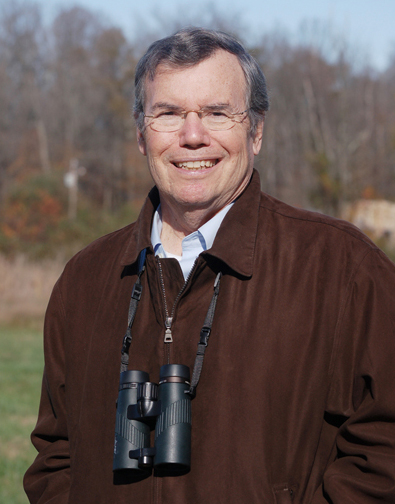 Bob Musil is the President & CEO of the Rachel Carson Council and author of Rachel Carson and Her Sisters: Extraordinary Women Who Have Shaped America’s Environment (Rutgers, 2016) and Washington in Spring: A Nature Journal for a Changing Capital (Bartleby, 2016). He is also the editor of the forthcoming annotated edition from Rutgers University Press of Rachel Carson’s Under the Sea-Wind with his Introduction, updated marine science, and historic and contemporary illustrations and photographs. Bob Musil is the President & CEO of the Rachel Carson Council and author of Rachel Carson and Her Sisters: Extraordinary Women Who Have Shaped America’s Environment (Rutgers, 2016) and Washington in Spring: A Nature Journal for a Changing Capital (Bartleby, 2016). He is also the editor of the forthcoming annotated edition from Rutgers University Press of Rachel Carson’s Under the Sea-Wind with his Introduction, updated marine science, and historic and contemporary illustrations and photographs. | | | | | | How to Coexist With a Belligerent Catbird My childhood bedroom had a Jane Goodall quote on the wall — “My mission is to create a world where we can live in harmony with nature” — and I think this helps explain how I became a person who surrendered five blueberry bushes and my dignity to an angry catbird. We called her Catherine. The spring when my daughter was 2, Catherine claimed the entire garden beside our house as her domain. I discovered this when we went to pick blueberries from our bushes; as my toddler plucked the fruit, the bird began calling loudly. | | | | | | | | Quotes With Wings From poets, to authors, to the famous American naturalist and ornithologist Roger Tory Peterson, these quotes are inspiring and memorable. But first, a quote about quotes. “It is a good thing for an uneducated man to read books of quotations.” Winston S. Churchill. | | | | | | | | The Invasive-Species Debate Is Not Always Simple Where starlings are concerned, I thought my heart was a stone. Starlings descend in great flocks on orchards and farms, decimating crops and dining on feed meant for livestock. In the air, they can bring down airplanes. Their excrement fouls city streets and walkways. And that’s just the nuisance they cause to people. European starlings also outcompete native birds for roosts and nest holes. | | | | | | | | Several Birds Named After Philadelphians Will Be Renamed as Part of an Effort to Stop Honoring Enslavers and Racists. The American Ornithological Society will remove people’s names from birds. Many of those birds are now named after prominent Philadelphia scientists. For more than two centuries, American ornithologists have been naming birds after people. | | | | | | | | The Gentle Rain of Songbirds Spring migration, warfare, and human migration THEY know nothing of our wars and celebrations, our privilege and petty distractions. They fly just the same over Gaza as they do Washington, D.C., or the two Amazons. Day and night their wings beat and their lungs burn along migratory routes northbound toward an uncertain fate. All the while we ourselves go about our business, our routines, mostly unaware of their presence overhead — or their perils. | | | | | | | | Celebrating Links Across Species Amid a Nightmare of War Did you know that Gaza — well, Palestine — even has a national bird? The Palestine sunbird is a gorgeous creature, crowned in iridescent green and blue. “This bird is a symbol of freedom and movement, it can fly anywhere." He’s a funny little chap: a sharp dresser with a sleek grey jacket, a white waistcoat, red shorts, and a small grey crest for a hat. With his shiny black eyes and stubby black beak, he’s quite the looker. | | | | | | | | | | Creating Bird-friendly Buildings — On Campus and Beyond The Yale Bird-Friendly Building Initiative aims to accelerate the adoption of bird-friendly design to reduce deadly collisions. More than 1 billion birds are killed each year as a result of window collisions in North America alone, making buildings the leading human-caused driver of wild bird mortality. To help reduce these collisions, the Yale Bird-Friendly Building Initiative aims to accelerate the adoption of bird-friendly design on Yale’s campus and beyond. | | | | | | | | Updated NEPA Rules Are a Big Win for Climate, Communities, and Birds Improvements to the National Environmental Policy Act will increase community engagement and require that federal agencies consider climate impacts. Since it was first signed into law in 1970, the National Environmental Policy Act (NEPA) has been one of the most important statutes for protecting birds, other wildlife, and communities from the dangers of pollution, habitat impacts, and other environmental harm. | | | | | | | | Restored NEPA Centers Climate Change and Environmental Justice New rule strengthens the landmark National Environmental Policy Act. Today the Biden administration finalized a rule implementing changes to the National Environmental Policy Act (NEPA), the bedrock law that guides how federal agencies assess the potential environmental impacts of proposed actions and engage with communities. | | | | | | | | Protect Insects to Protect Birds World Migratory Bird Day has been raising awareness about the importance of migratory bird conservation since 1993. The theme of Migratory Bird Day this year, May 11, was “Protect Insects, Protect Birds." More than 100 species of birds that nest in the Midwest, and many more that migrate through, are considered neotropical migrants, meaning they breed in North America and spend the winter in Mexico, Central America, South America, or the Caribbean. | | | | | | | | Neotropical Migratory Bird Conservation Bill Signed into Law The Migratory Birds of the Americas Conservation Enhancements Act Will Help Reverse Bird Declines In good news for migratory birds, on Wednesday, April 24, 2024, President Biden signed into law the Migratory Birds of the Americas Conservation Enhancements Act (H.R.4389). This bill reauthorizes the Neotropical Migratory Bird Conservation Act (NMBCA), a successful federal grants program funding migratory bird research and habitat restoration throughout the Western Hemisphere. | | | | | | | | EcoForesters and Audubon North Carolina Offer New Golden-winged Warbler Program for Private Landowners New partnership will provide funding and habitat management guidance for western NC landowners interested in helping a declining songbird. EcoForesters, in collaboration with Audubon North Carolina, will soon be offering financial assistance and habitat management guidance to Mitchell and Yancey County landowners who are interested in restoring critical bird habitat for Golden-winged Warblers. | | | | | | | | “Frisky little songbird” Needs Protection From Sea Level Rise, Environmental Group Tells Feds Center for Biological Diversity petitions to put saltmarsh sparrow on Endangered Species list. An environmental organization is asking the federal government to list the saltmarsh sparrow, a bird living on wetlands on the east coast, including Virginia, for protection under the Endangered Species Act due to expected losses from sea level rise and human development. | | | | | | | | A Few Words About Nests Spring is proceeding apace in this yard, despite my worst fears. For 28 of the 29 years that my husband and I have lived in this house, the elderly widow next door mostly shared our commitment to a natural yard. And because her house backed up to a little patch of woods, too, between us we managed to create a miniature wildlife sanctuary. I could sit outside in springtime and hold very still while a tufted titmouse pulled hairs from my head and carried them to her nest in the yard next door. | | | | | | | | A Flamingo Flock Inspires Hope: Have the Rare Birds Returned to the Everglades For Good? For the last century, flamingos in Florida were more likely to be spotted on T-shirts and cups in a souvenir shop than flapping around in the wild. Then last summer, a flock of the rare and beautiful birds—a group is fittingly known as a "flamboyance" of flamingos—was blown to Florida on the fierce winds of Hurricane Idalia. | | | | | | | | What to Do if You Find a Bird Nest Near Your Home Birds make nests over front doors, on porches and patios, even on cars. Here’s how to keep one safe. If you live in a city or suburb, it can be hard to feel connected to nature. But next time you step outside, pause, look and listen — even in the most densely populated areas, birds are almost omnipresent. And no matter where you live, that can be a kind of magic, especially during nesting season. | | | | | | | | Preventable Loss: A Billion Birds Die Each Year From Window Strikes University of Cincinnati ornithologist Ron Canterbury displayed dozens of birds that died from striking glass windows in the city. It’s a tiny fraction of those he and his students have collected in recent years for his long-term study on window-strike mortality. Here were magnolia warblers, American redstarts, white-throated sparrows, tiny hummingbirds and larger mourning doves and woodpeckers. | | | | | | | | Echoes of “Silent Spring”: How the Wood Pellet Industry Will Silence Birds I first read Rachel Carson’s Silent Spring while sitting on my porch in the evenings after school, surrounded by the vibrant calls of Carolina Chickadees, Northern Cardinals, and American Goldfinches visiting my nearby bird feeders. As I turned the pages, I was transported into a world where the beauty of those same melodies was under grave threat. | | | | | | | | A Quest to Bring Back Habitat For Grassland Birds For decades, the call of the Northern bobwhite quail was synonymous with life on the farm along Maryland’s Eastern Shore. The bird’s pleasing chirp, a whistling bob-white that sweeps upward in pitch, would ring across the field during spring breeding season, around the time when farmers planted their crops. “Quail are very vocal and easy to see when they're around, so people want to hear and see them again,” said Dan Small, coordinator of the Natural Lands Project at Washington College. | | | | | | | | Behind the Birdsong Project: Alex Somers Before it won a GRAMMY for Best Boxed or Special Limited Edition Package, For The Birds: The Birdsong Project was a seed of an idea from co-creators Randall Poster and Rebecca Reagan. It was their initial pitch that drew in the more than 200 musical artists, visual artists, and actors who participated in the project—including musician Alex Somers. The unprecedented scale of the endeavor immediately hooked Somers: “The Birdsong Project was so massive that people from so many different music communities had at least one friend who was a part of it.” | | | | | | | | A Photographic Atlas to Spark a Lifelong Love of Birds Birds of North America: A Photographic Atlas is a sweeping project from Bruce M. Beehler and photo editor Brian E. Small to document all 1,144 bird species in North America, including Hawaii. American Bird Conservancy (ABC) is proud to sponsor the book, with one-third of proceeds from the book benefiting ABC's work to conserve wild birds and their habitats throughout the Americas. The book is available through Johns Hopkins University Press. | | | | | | | | Black Birders Week 2024 at the Smithsonian At the Smithsonian, we are teaming up with Black AF in STEM to celebrate Black Birders Week by offering a series of programs and experiences in Washington, D.C. We support Black AF In STEM’s work to celebrate and highlight birding as a lifelong learning journey that is enjoyed by Black cultures across the diaspora. Participating from the Smithsonian are the National Museum of Natural History and the National Museum of African American History and Culture (NMAAHC). | | | | | | | | | | | | Black-necked Stilt This is one of the most easily recognized birds in America with its long, bright pink legs and striking black and white coloration. Black-necked Stilts are often found in the same areas as the American Avocet—mainly shallow water in open country, mudflats and marshes, but with a preference for fresh water. | | | | | | | | Momentary Meditations are published every Monday to awaken what Rachel Carson called “the sense of wonder” and what Albert Schweitzer called “a reverence for life.” Looking deeply into our interdependence with all life on earth helps us know what we must do. In our harried world, these meditations are meant to serve as a renewable resource for compassion and love. Short Flight - Standing upwind of this Great Blue Heron, and thinking I was out of sight, I lifted my camera. In that instant, the great bird stopped, faced the wind, and took off for a safer shoreline. | | | | | | | | The Backyard Bird Chronicles By Amy Tan 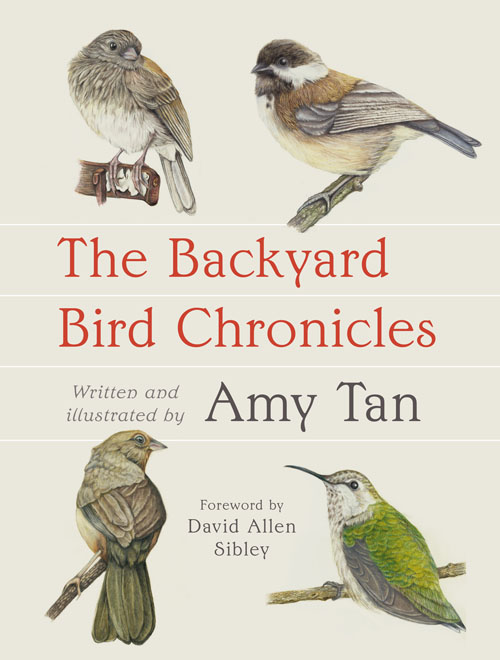 #1 NEW YORK TIMES BESTSELLER • A gorgeous, witty account of birding, nature, and the beauty around us that hides in plain sight, written and illustrated by the best-selling author of The Joy Luck Club • With a foreword by David Allen Sibley. #1 NEW YORK TIMES BESTSELLER • A gorgeous, witty account of birding, nature, and the beauty around us that hides in plain sight, written and illustrated by the best-selling author of The Joy Luck Club • With a foreword by David Allen Sibley.
“Unexpected and spectacular” —Ann Patchett, best-selling author of These Precious Days
“The drawings and essays in this book do a lot more than just describe the birds. They carry a sense of discovery through observation and drawing, suggest the layers of patterns in the natural world, and emphasize a deep personal connection between the watcher and the watched. The birds that inhabit Amy Tan’s backyard seem a lot like the characters in her novels.” —David Allen Sibley, from the foreword
Tracking the natural beauty that surrounds us, The Backyard Bird Chronicles maps the passage of time through daily entries, thoughtful questions, and beautiful original sketches. With boundless charm and wit, author Amy Tan charts her foray into birding and the natural wonders of the world. In 2016, Amy Tan grew overwhelmed by the state of the world: Hatred and misinformation became a daily presence on social media, and the country felt more divisive than ever. In search of peace, Tan turned toward the natural world just beyond her window and, specifically, the birds visiting her yard. But what began as an attempt to find solace turned into something far greater—an opportunity to savor quiet moments during a volatile time, connect to nature in a meaningful way, and imagine the intricate lives of the birds she admired. Read more and purchase | | | | | | The May 2024 issue of Bird Watch and Wonder was produced by Ross Feldner | | | | | |  The Rachel Carson Council Depends on Tax-deductible Gifts From Concerned Individuals Like You. Please Help If You can. The Rachel Carson Council Depends on Tax-deductible Gifts From Concerned Individuals Like You. Please Help If You can. | | | |  Sign Up Here to Receive the RCC E-News and Other RCC Newsletters, Information and Alerts. Sign Up Here to Receive the RCC E-News and Other RCC Newsletters, Information and Alerts. | | | | | | | | | | | |